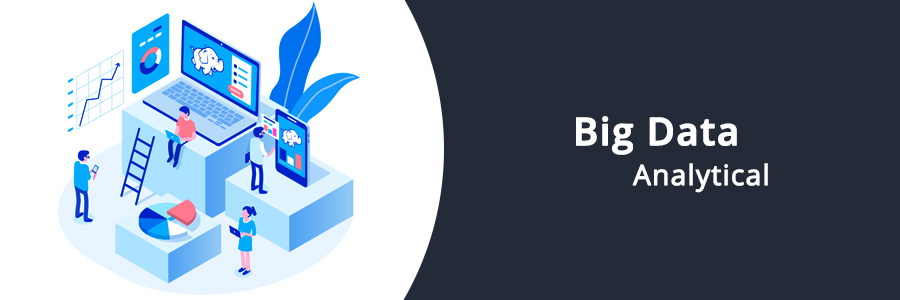Big Data Analytical Tools Key Features and Everything You Need to Know

Talking about Big data analytics, it is the process which is generally used test various and massive amount of data sets to uncover market trends, unknown correlations, hidden patterns, and more. It helps a business to come up with effective decisions. But how to process such massive data and get accurate results? This is where you will have to employ Big data analytical tool. The tools are designed to process the data quite fast with maximum level of efficiency. The tools save money as well time.
There are lots of tools available for Big data analysis, which can significantly enhance the data analyzing process. The process includes data analysis, cleansing, mining, visualization, integration, and management.
With the tremendous rise of Big Data and cloud computing, the cutting edge Big data analytics solutions tools have emerged as major facto to obtain a meaningful analysis of data. In this article, you will get to know about some significant tools and their features. So, let’s get started.
1. Apache Storm
It is a popular open-source and free to use big data competition tool. This Apache product offers a real-time framework to facilitate adequate data streaming to support different programming languages. Besides, it provides users with fault-tolerant and distributed real-time processing system. The best thing about the tool is it comes with faster Big data computing ability. It has scheduler which effectively manages the workload of different nodes concerning topology configuration. Apache Storm works perfectly with HDFS- the Hadoop Distributed File System. Now let’s look into the features of Apache Storm:
- It can process more than 1 million 100 bytes messages in a second per node
- The data unit will be efficiently processed at minimal errors.
- The maximum level of horizontal scalability
- Coms with fault tolerance feature
- If crashes, it restarts automatically
- Works perfectly with DAG topology- Direct Acyclic Graph
- Offers JSON format output files
- Multiple-use cases such as ETL, log processing, machine learning and more.
2. Talend
This fantastic Big data tool greatly simplifies and automates the integration of big data. Talend’s graphical wizards produce native code. It lets the users to carry out management of master data, big data integration and quality check of bigdata. Talking about its features:
- Facilitates better speed to real-time data processing
- Streamline ELT and ETL for analysis of big data
- Offers great speed
- Can effectively handle different sources of data
- On a single platform, it provides various connector. The means users can customize the solution as per their requirements.
- Generates native code and simplifies Spark and MapReduce
- Uses natural language and machine learning processing to evaluate data quality
- Agile DevOps to boost the big data projects
- Reduces the challenges related to different DevOps processes
3. Apache Couch DB
A document-oriented, cross-platform and open-source NoSQL database which eases the use and maintaining the scalable architecture. The tool is developed based on Erlang, a concurrency-oriented language. It stores all the data in JSON document format. Users can access the data through JavaScript. Couch DB comes with fault-tolerant storage and provides distributed scaling. The data accessing process works on the Couch Replication Protocol. Coming to the feature of Apache Couch DB:
- It is single-node database and functions just like other databases
- Enables users to run a single logical database on different servers
- It uses the HTTP protocol and supports JSON format
- Makes document update, insertion, deletion, and retrieval a lot easier
- The JSON- JavaScript Object Notation can be easily converted into various languages
4. Apache Spark
When it comes to choosing a perfect Big data analytics tools, you can’t ignore Apache Spark. It has more than 80 high-level operators to make parallel apps. Different major organizations use Spark for large database processing. The significant features of Apache Spark are:
- Helps to run the applications in Hadoop, ten times faster on disk an around 100 times faster in memory.
- You will enjoy a super fact big data processing
- Offers sophisticated data analytics feature
- Can be easily integrated with Hadoop data analytics tool and you can use your old Hadoop data in this tool.
- Comes with in-built APIs for Scala, Python, and Java
- It has in-memory data processing ability. In general, this is something much faster than MapReduce’s disk processing.
- Works perfectly with HDFC, Apache Cassandra, HDFS and more. Besides, it supports cloud services, which adds another layer of versatility.
5. RapidMiner
The tool uses visual programming and can manipulate, analyze, and model the data. It makes data science teams easier and increases productivity through its open-source platform. No matter what the task is, whether it is data preparation, machine learning or model deployment, this tool is perfect. The features of RapidMiner are:
- Supports different methods of big data management
- Offer batch and GUI data processing
- Easily integrates with existing database
- Very interactive and comes with sharable dashboards
- Best for predictive analytics
- Facilitates remote data analysis
- Supports data merging, aggregating, joining and filtering
- Builds and validates predictive models
- Notifications feature
6. DataCleaner
It is a popular data quality applications and effective big data analysis solution platform. Besides, it comes with a robust data profiling engine. DataCleaner is extensible and offers facilities like data matching, merging, transformation, and cleansing. Let’s look at the features of DataCleaner Big data analytics tools.
- Can detect fuzz duplication of data
- Interactive and explorative
- Data standardization and transformation
- Supports data reporting and data validation
- Combines data ingestion pipeline with Hadoop development services
- Ensures correctness of data rules before the beginning of big data processing
7. Hadoop
Hadoop is the long-standing winner in the Big data analysis industry. It is famous for its ability to handle massive data processing. It doesn’t need any high-level of configuration and can efficiently run in the cloud and on-prem. The major Hadoop features and benefits are:
- Comes with HDFS- Hadoop Distributed File System and can work with massive bandwidth
- Offers well configurable model to make the big data processing a lot easier
- Comes with Hadoop resource management and Hadoop libraries
It is the best open-source big data analysis platform which is written in the Java language. Besides, it offers cross-platform support. More than 50 Fortune companies are using Hadoop. For example, Hortonworks, AWS- Amazon Web Services, Intel, Facebook, IBM and more. Its features are:
- Support HTTP proxy server authentication
- Supports POSIX style file system
- Comes with a productive ecosystem which perfectly matches the developer’s analytical needs.
- Brings maximum flexibility in Big data processing
8. Lumify
It is a visualized platform and effective big data analysis too. Lumify comes with different analytic options which help users to explore more connections and relationship in the data. Some of its significant features are:
- Offers 2D as well as 3D visualizations
- Links data analysis with mapping systems, graph entities, geospatial analysis, and multimedia analysis
- Comes with unique ingest processing for images, videos, and textual content
- Builds proven, and highly scalable data technology
- Supports cloud services
With time, the volume of data is increasing rapidly. For accurate data analysis, it is quite essential to have some best Big data analysis solution. Big data is not a trend; it emerges as a business practice. So, prefer to use the best tools and witness increased revenue.
